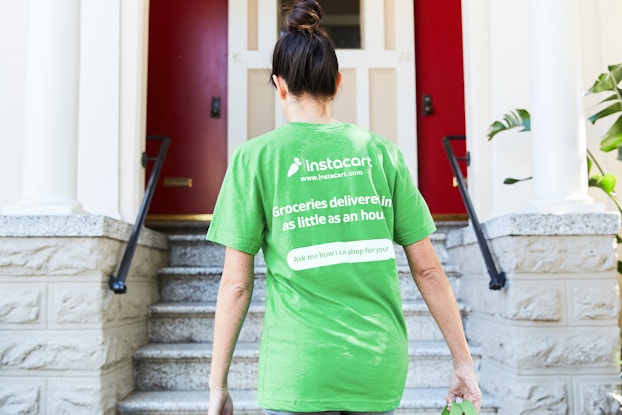
For as many people among us who are panic-buying toilet paper and toothpaste (and flipping out at the sight of empty shelves), there are thousands who are skipping the in-store experience altogether and shifting to delivery apps for everything from groceries to lattes and lunches. In fact, there have been a record number of downloads in the past week alone, according to data from Apptopia, an independent research firm that analyzes the app marketplace.
At the same time, an unprecedented number of restaurants have shuttered across the country. Analysis from the data science team at Womply of transaction trends year over year at 400,000 local businesses across the country, including 48,000 restaurants and 4,600 bars, revealed that revenue on March 13 was down 19.6% year over year. “With many restaurants closed or only open for takeout, that number should continue to drop rapidly,” the firm found.
By contrast, “Driven by consumer panic, grocery stores saw their highest daily revenues for 2020 last Friday, with consumer spending up 87.4% year over year,” the analysts said. Relatedly, curbside pickup is also on the rise.
These huge swings on both sides beg the question: Can delivery apps not only help keep us healthier, but also help save the economy during the coronavirus crisis?
“U.S. consumer interest for restaurants has fallen by 54%, and for nightlife businesses by 69%,” according to Yelp’s data science editor Carl Bialik. “Pizzerias, fast food restaurants, grocery stores, and fruits and veggies shops are all grabbing a much bigger share of the pie than they were a week ago (up 44%, 64%, 160%, and 102%, respectively, in share of daily U.S. consumer actions,” he wrote.
Apptopia’s data suggests that the surge in downloads may prove fruitful. Their report found that March 15 was a new record for Instacart, Walmart Grocery, Shipt and Target that represented an increase of 218%, 160%, 124% and 98%, respectively, over the average number of daily downloads in February.
Now that residents in major cities such as San Francisco have been directed to “shelter in place,” that is, stay home unless they have a medical reason or to obtain necessary supplies, those numbers may get a further boost.
Driven by consumer panic, grocery stores saw their highest daily revenues for 2020 last Friday, with consumer spending up 87.4% year over year.
Womply
Coronavirus Guide for Small Businesses
CO— is working to bring you the best resources and information to help you navigate this challenging time. Read on for our complete coronavirus coverage.
‘Leave at my door’ deliveries surge
Instacart, for one, has taken extra measures to ensure that deliveries can be made as safely as possible. In a Medium post, the company said, “We've worked closely with a panel of health and safety experts to develop a robust set of guidelines to ensure you’re able to continue shopping safely. Our goal is to make sure you have the resources you need to take the appropriate preventative actions and make use of precautionary food handling measures.”
That includes its “Leave at My Door Delivery” feature, which the company said was originally designed to provide a more flexible option for customers that may not be home at the time of delivery. In the first week of March, for one, “we observed a significant surge in consumer adoption and opt-in usage of the feature,” Instacart said in a statement.
During that time period, more than 25% of all orders utilized this feature, the company stated. The following weekend, “Instacart experienced the highest customer demand in its history in the amount of groceries sold on our platform,” the company said in a statement. “The average customer’s purchase is up more than 20% month-over-month and includes items like hand sanitizer, vitamins, powdered milk, diapers, face masks, and canned goods.”
[Instacart may have been making safety and convenience a priority for its customers, however, the company's gig workers, who handle the in-store shopping and delivery, are saying otherwise, planning a nationwide walkout on March 30. They say Instacart is failing to provide hand sanitizer, disinfectant wipes and soap to them for free, nor will it provide hazard pay of an additional $5 per order, the workers say. Until Instacart provides these things as well as extends paid sick leave to at-risk workers with pre-existing conditions, those participating in the walkout won't be reporting for duty.]
Hungryroot, an online grocery service has also experienced significant growth in both customer acquisition and reorder rates recently, and they expect the uptick in demand to continue. “We're also making notable changes to both our supply chain and delivery model (e.g., same day delivery) to ensure we can continue meeting the demand for those customers in need,” the company said in a statement.

Blue Apron makes a comeback
Both Blue Apron and Waitr Holdings meal delivery services experienced stock surges, as demand has increased for their meal kits. Waitr stock increased tenfold. To meet this demand, Blue Apron’s CEO Linda Findley Kozlowski said in an emailed statement: “We are hiring for temporary and permanent positions in our Linden, New Jersey, and Richmond, California, fulfillment centers and hope to create employment opportunities for individuals who may have been displaced by the restaurant or foodservice industry.”
For it’s part, Starbucks has moved to mobile ordering and takeout only as of March 15. The company declined to provide details on the number of app downloads or business metrics at this time.
Not all delivery options are experiencing this surge. Even with contactless delivery, Uber Eats, Grubhub, DoorDash and the like are reportedly slowing down, in part as consumers reacted to both the expense of ordering prepared meals from restaurants and the relative safety of knowing how their food was prepared at home.
The upshot, according to Bain analysts, was that it’s unclear whether the economy of food will carry us through these uncertain financial times. As Marc-André Kamel and Joëlle de Montgolfier wrote, “Few businesses could hope to predict the course of the pandemic with any accuracy. However, retailers do have the power to quickly develop and roll out contingency plans to address the crisis head-on and ensure business continuity, while playing their role in minimizing the virus’s spread.”
CO—is committed to helping you start, run and grow your small business. Learn more about the benefits of small business membership in the U.S. Chamber of Commerce, here.








